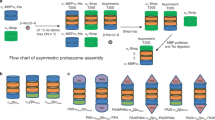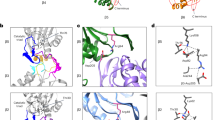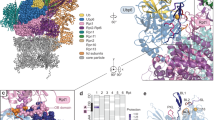Abstract
The core particle (CP) of the yeast proteasome is composed of four heptameric rings of subunits arranged in a hollow, barrel-like structure. We report that the CP is autoinhibited by the N-terminal tails of the outer (α) ring subunits. Crystallographic analysis showed that deletion of the tail of the α3-subunit opens a channel into the proteolytically active interior chamber of the CP, thus derepressing peptide hydrolysis. In the latent state of the particle, the tails prevent substrate entry by imposing topological closure on the CP. Inhibition by the α-subunit tails is relieved upon binding of the regulatory particle to the CP to form the proteasome holoenzyme.
This is a preview of subscription content, access via your institution
Access options
Subscribe to this journal
Receive 12 print issues and online access
$189.00 per year
only $15.75 per issue
Buy this article
- Purchase on Springer Link
- Instant access to full article PDF
Prices may be subject to local taxes which are calculated during checkout





Similar content being viewed by others
Accession codes
References
Bochtler, M., Ditzel, L., Groll, M., Hartmann, C. & Huber, R. The proteasome. Ann. Rev. Biophys. Biomol. Struct. 28, 295–317 (1999).
Schmidt, M., Lupas, A.N. & Finley, D. Structure and mechanism of ATP-dependent proteases. Curr. Op. Chem. Biol. 3, 584–591 (1999).
Voges, D., Zwickl, P. & Baumeister, W. The 26S proteasome: a molecular machine designed for controlled proteolysis. Ann. Rev. Biochem. 68, 1015–1068 (1999).
De Mot, R., Nagy, I., Walz, J. & Baumeister, W. Proteasomes and other self-compartmentalizing proteases in bacteria. Trends Microbiol. 7, 88–92 ( 1999).
Groll, M. et al. Structure of the 20S proteasome from yeast at 2.4 Å resolution . Nature 386, 463–471 (1997).
Chu-Ping, M., Vu, J.H., Proske, R.J., Slaughter, C.A. & DeMartino, G.N. Identification, purification, and characterization of a high molecular weight, ATP-dependent activator (PA700) of the 20S proteasome. J. Biol. Chem. 269, 3539–3547 (1994).
Hoffman, L. & Rechsteiner, M. Activation of the multicatalytic protease. J. Biol. Chem. 269, 16890–16895 (1994).
Coux, O., Tanaka, K. & Goldberg, A.L. Structure and functions of the 20S and 26S proteasomes . Ann. Rev. Biochem. 65, 810– 847 (1996).
DeMartino, G.N. & Slaughter, C.A. The proteasome, a novel protease regulated by multiple mechanisms. J. Biol. Chem. 274, 22123–22126 ( 1999).
Rechsteiner, M., Realini, C & Ustrell, V. The proteasome activator 11S REG (PA28) and class I antigen presentation. Biochem. J. 345, 1–15 (2000).
Glickman, M.H. et al. A subcomplex of the proteasome regulatory particle required for ubiquitin conjugate degradation and related to the COP9-signalosome and eIF3. Cell 94, 615–623 (1998).
Rubin, D.M. et al. Active site mutants in the six regulatory particle ATPases reveal multiple roles for ATP in the proteasome. EMBO J. 17, 4909–4919 (1998).
Lupas, A. & Baumeister, W. In Ubiquitin and the Biology of the Cell (eds Peters, J., Harris, R. & Finley, D.) 127–146 (Plenum Press, New York, 1998 ).
Löwe, J. et al. Crystal structure of the 20S proteasome from the archeon T. acidophilum at 3.4 Å resolution. Science 268, 533–539 (1995).
Arendt, C.S. & Hochstrasser, M. Identification of the yeast 20S proteasome catalytic centers and subunit interactions required for active-site formation. Proc. Nat. Acad. Sci. USA 94, 7156–7161 (1997).
Dick, T.P. et al. Contribution of proteasomal beta subunits to the cleavage of peptide substrates analyzed with yeast mutants. J. Biol. Chem. 273, 25637–25346 ( 1998).
Bachmair, A., Finley, D. & Varshavsky, A. In vivo half-life of a protein is a function of its amino-terminal residue. Science 234, 179 –186 (1986).
Khan, A.R. & James, M.N. Molecular mechanisms for the conversion of zymogens to active proteolytic enzymes. Protein Sci. 7, 815–836 (1998).
Schmidtke, G. et al. Analysis of mammalian 20S proteasome biogenesis: the maturation of β-subunits is an ordered two-step mechanism involving autocatalysis . EMBO J. 15, 6887–6898 (1996).
Chen, P. & Hochstrasser, M. Autocatalytic subunit processing couples active site formation in the 20S proteasome to completion of assembly. Cell 86, 961– 972 (1996).
Ditzel, L. et al. Conformational constraints for protein self-cleavage in the proteasome. J. Mol. Biol. 279, 1187– 1191 (1998).
Groll, M. et al. The catalytic sites of 20S proteasomes and their role in subunit maturation: a mutational and crystallographic study. Proc. Nat. Acad. Sci. USA 96, 10976–10983 (1999).
Finley, D., Ozkaynak, E. & Varshavksy, A. The yeast polyubiquitin gene is essential for resistance to high temperatures, starvation, and other stresses. Cell 48, 1035–1046 (1987).
Gietz, R.D. & Sugino, A. New yeast-Escherichia coli vectors constructed with in vitro mutagenized yeast genes lacking six-base pair restriction sites. Gene 74, 527– 534 (1988).
Rothstein, R. Targeting, disruption, replacement, and allele rescue: integrative DNA transformation in yeast. Methods Enzymol. 194, 281– 301 (1991).
Guarente, L. Yeast promoters and LacZ fusions designed to study expression of cloned genes in yeast. Methods Enzymol. 101, 181– 191 (1983).
Leslie, A.G.W. Mosfilm user guide, mosfilm version 5.2. (MRC Laboratory of Molecular Biology, Cambridge, UK; 1994).
Brünger, A.T. X-PLOR, Version 3.1. A system for X-ray crystallography and NMR. (Yale University Press, New Haven, Connecticut; 1992).
Brünger, A.T. Free R value: a novel statistical quantity for assessing the accuracy of crystal structures. Nature 355, 472– 475 (1992).
Turk, D. Weiterentwicklung eines Programms für Molekulargraphik und Elektronendicht-Manipulation und seine Anwendung auf verschiedene Protein-Strukturaufklärungen. (Dissertation Technische Universität München; 1992 ).
Jones, T.A. A graphic model building and refinement system for macromolecules. J. Appl. Crystallogr. 11, 268–272 (1978).
Glickman, M.H., Rubin, D.M., Fried, V.A. & Finley, D. The regulatory particle of the Saccharomyces cerevisiae proteasome. Mol. Cell. Biol. 18, 3149–3162 (1998).
van Nocker, S. et al. The multiubiquitin-chain-binding protein Mcb1 is a component of the 26S proteasome in Saccharomyces cerevisiae and plays a nonessential, substrate-specific role in protein turnover. Mol. Cell. Biol. 16, 6020–6028.
Acknowledgements
This work was supported by the NIH grant (to D.F.), the Foundation for the Promotion of Research at the Technion (M.H.G.), The US-Israel Binational Science Foundation (to M.H.G. and D.F.) and the Deutsche Forschungsgemeinschaft (to R.H.). A.K. was partially supported by a fellowship from the Studienfoerderung Cusanuswerk. The authors thank C. Larsen and G. Dittmar (Harvard) for generous assistance with computer imaging, K. Mann (Max-Planck-Institut für Biochemie, Martinsried, Germany) for help with N-terminal sequence analysis, and G. Bourenkow and H. Bartunik (DESY, Hamburg, Germany) for assistance with X-ray experiments.
Author information
Authors and Affiliations
Corresponding authors
Rights and permissions
About this article
Cite this article
Groll, M., Bajorek, M., Köhler, A. et al. A gated channel into the proteasome core particle. Nat Struct Mol Biol 7, 1062–1067 (2000). https://doi.org/10.1038/80992
Received:
Accepted:
Issue Date:
DOI: https://doi.org/10.1038/80992
This article is cited by
-
Allosteric regulation of the 20S proteasome by the Catalytic Core Regulators (CCRs) family
Nature Communications (2023)
-
Minimal mechanistic component of HbYX-dependent proteasome activation that reverses impairment by neurodegenerative-associated oligomers
Communications Biology (2023)
-
Immortalized Alzheimer’s Disease Astrocytes: Characterization of Their Proteolytic Systems
Molecular Neurobiology (2023)
-
POH1/Rpn11/PSMD14: a journey from basic research in fission yeast to a prognostic marker and a druggable target in cancer cells
British Journal of Cancer (2022)
-
PA28γ–20S proteasome is a proteolytic complex committed to degrade unfolded proteins
Cellular and Molecular Life Sciences (2022)



